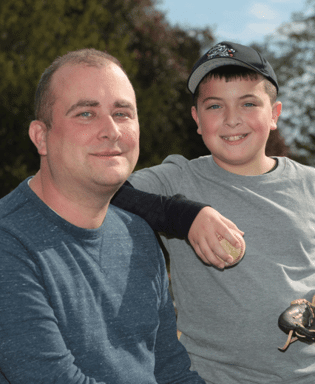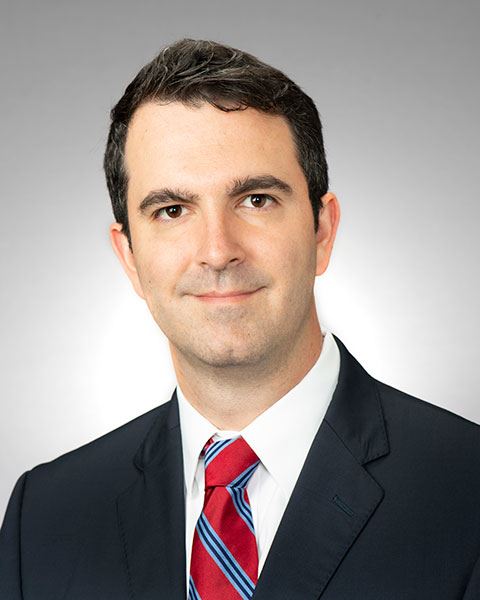"I was in the hospital only two nights and am very pleased with the entire process."

Patrick Gazzara of Manchester didn’t understand what was happening to him. The then-41-year-old contract administrator and single father had just hopped into the shower on a Sunday morning in January 2020. “When the hot water hit and I bent a certain way, I felt these pulsating sensations,” he says. “My right side was just going ba-boom, ba-boom, ba-boom, as if somebody was beating my rib cage like a bass drum.” He had never felt anything like it. Two or three minutes after starting, the sensations disappeared.
He might have dismissed the episode if the same thing hadn’t happened four or five more times during spring and summer as the COVID-19 pandemic swept the country. “Each episode increased in intensity,” Patrick says. “They seemed triggered by stress or a change in temperature such as jumping into a friend’s cold pool on a hot day.”
Patrick’s primary care doctor ordered X-rays that found nothing. A neurologist ruled out epilepsy but made no diagnosis. Seemingly at an impasse heading into fall, Patrick noticed that he’d sometimes have bouts of confusion, struggle to find words, repeat himself in conversations and become unusually snappish.
By October, stress was ramping up. Patrick was working at home, his 9-year-old son Danny’s virtual-learning school year was in full swing and they were involved as much as possible with activities like Cub Scouts and baseball. Then came what Patrick calls “the big one.”
A Solvable Problem
The pulsations hit on a Tuesday after school—“10 times worse than before,” Patrick says. Sensations traveled his entire right side from his core down to his toes and up to his brain. He then lost feeling in his right leg and rib cage, and collapsed to his bedroom floor. “I thought I was having an aneurysm or stroke,” Patrick says. Unable to speak, he let out a garbled scream for help before losing consciousness for about 15 minutes. “My son texted his mother to say I was dying,” Patrick says.
When Patrick’s father drove him to the emergency room at Community Medical Center (CMC) after Danny’s mother picked up their son, the problem finally became clear. Patrick was having focal motor seizures— uncontrolled, sustained bursts of electrical activity due to irritation of the brain’s motor cortex.
Underlying the seizures: Patrick had a meningioma—a benign tumor in the membrane surrounding his brain. Patrick’s tumor had reached 7 cm and was growing larger, putting pressure on his brain and causing both neurologic deficits and seizure-triggering irritation.

Benign meningiomas can be managed one of three ways, says Stephen A. Johnson, MD, Director of the Cranial Nerve Disorders Program at CMC and Robert Wood Johnson University Hospital in New Brunswick, and Assistant Professor of Neurosurgery at Rutgers Robert Wood Johnson Medical School. “You can observe it and take no action; you can administer a special form of radiation that inactivates the tumor; or you can do surgery,” Dr. Johnson says. “We have a comprehensive, multidisciplinary program that offers all three options, so we can offer unbiased opinions.”
Daunted by the prospect of brain surgery, Patrick sought advice from multiple doctors. “Dr. Johnson strongly recommended surgery and said I had an excellent chance of a complete recovery,” Patrick says. “I felt I was in great hands with him. After consultation with my family, I decided to proceed with surgery.”
High-Impact Procedure
In a four-hour procedure, Dr. Johnson and his team separated the tumor from Patrick’s brain and critical blood vessels. It’s a delicate operation performed under high-powered magnification, but one that’s rewarding for patients and surgeons alike. “Without surgery, meningioma patients can do very poorly and have devastating problems,” Dr. Johnson says. “With surgery, we can cure people and have them do fantastically well. It’s one of the most satisfying procedures I do.”
Patrick’s seizures resolved. They had left residual muscle and nerve damage on his right side, but regular physical therapy has helped restore strength and balance. “I was in the hospital only two nights and am very pleased with the entire process,” Patrick says. “I am extremely grateful it was handled the right way.” He’s on the road to a full recovery and has a goal of running 5Ks to raise funds for brain tumor research.
His terrifying “big one” has made him feel even closer with his son. “Life is tricky,” Patrick says. “You have to take advantage of the time you have.” The two have been even more diligent about bonding activities like summer trips to Ocean City and the National Baseball Hall of Fame and Museum.
“The whole experience taught me to pay attention to health a little more than previously,” Patrick says. “The pandemic has taken a lot out of a lot of people, and it’s easy to neglect yourself. Listen to your body. If you’re having problems, take care of them and don’t put them off. I’m not sure where I’d be if I hadn’t had an excellent surgical team helping me out.”
Learn more about neurologic treatments at Community Medical Center.